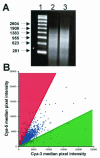Impact of human cytomegalovirus latent infection on myeloid progenitor cell gene expression
- PMID: 15047822
- PMCID: PMC374258
- DOI: 10.1128/jvi.78.8.4054-4062.2004
Impact of human cytomegalovirus latent infection on myeloid progenitor cell gene expression
Abstract
Herpesviruses establish lifelong latent infections in their hosts. Human cytomegalovirus (CMV) targets a population of bone marrow-derived myeloid lineage progenitor cells that serve as a reservoir for reactivation; however, the mechanisms by which latent CMV infection is maintained are unknown. To gain insights into mechanisms of maintenance and reactivation, we employed microarrays of approximately 26,900 sequence-verified human cDNAs to assess global changes in cellular gene expression during experimental CMV latent infection of granulocyte-macrophage progenitors (GM-Ps). This analysis revealed at least 29 host cell genes whose expression was increased and six whose expression was decreased during CMV latency. These changes in transcript levels appeared to be authentic, judging on the basis of further analysis of a subset by semiquantitative reverse transcription-PCR. This study provides a comprehensive snapshot of changes in host cell gene expression that result from latent infection and suggest that CMV regulates genes that encode proteins involved in immunity and host defense, cell growth, signaling, and transcriptional regulation. The host genes whose expression we found altered are likely to contribute to an environment that sustains latent infection.
Figures



Similar articles
-
A novel viral transcript with homology to human interleukin-10 is expressed during latent human cytomegalovirus infection.J Virol. 2004 Feb;78(3):1440-7. doi: 10.1128/jvi.78.3.1440-1447.2004. J Virol. 2004. PMID: 14722299 Free PMC article.
-
Viral gene expression during the establishment of human cytomegalovirus latent infection in myeloid progenitor cells.Blood. 2006 Dec 1;108(12):3691-9. doi: 10.1182/blood-2005-12-026682. Epub 2006 Aug 24. Blood. 2006. PMID: 16931631
-
A myeloid progenitor cell line capable of supporting human cytomegalovirus latency and reactivation, resulting in infectious progeny.J Virol. 2012 Sep;86(18):9854-65. doi: 10.1128/JVI.01278-12. Epub 2012 Jul 3. J Virol. 2012. PMID: 22761372 Free PMC article.
-
[Persistent/latent infection of human beta-herpesvirus].Nihon Rinsho. 1998 Jan;56(1):83-9. Nihon Rinsho. 1998. PMID: 9465670 Review. Japanese.
-
Epigenetic regulation of human cytomegalovirus latency: an update.Epigenomics. 2014;6(5):533-46. doi: 10.2217/epi.14.41. Epigenomics. 2014. PMID: 25431945 Review.
Cited by
-
Transcriptome altered by latent human cytomegalovirus infection on THP-1 cells using RNA-seq.Gene. 2016 Dec 5;594(1):144-150. doi: 10.1016/j.gene.2016.09.014. Epub 2016 Sep 10. Gene. 2016. PMID: 27623506 Free PMC article.
-
Whole Blood versus Plasma Samples-How Does the Type of Specimen Collected for Testing Affect the Monitoring of Cytomegalovirus Viremia?Pathogens. 2022 Nov 19;11(11):1384. doi: 10.3390/pathogens11111384. Pathogens. 2022. PMID: 36422636 Free PMC article.
-
iTRAQ-Based Proteomics Analysis of Human Cytomegalovirus Latency and Reactivation in T98G Cells.J Virol. 2022 Jan 26;96(2):e0147621. doi: 10.1128/JVI.01476-21. Epub 2021 Nov 3. J Virol. 2022. PMID: 34730396 Free PMC article.
-
Human cytomegalovirus modulates monocyte-mediated innate immune responses during short-term experimental latency in vitro.J Virol. 2014 Aug;88(16):9391-405. doi: 10.1128/JVI.00934-14. Epub 2014 Jun 11. J Virol. 2014. PMID: 24920803 Free PMC article.
-
Human Cytomegalovirus Latency: Approaching the Gordian Knot.Annu Rev Virol. 2016 Sep 29;3(1):333-357. doi: 10.1146/annurev-virology-110615-042422. Epub 2016 Aug 4. Annu Rev Virol. 2016. PMID: 27501258 Free PMC article.
References
-
- Alcaide-Loridan, C., A. M. Lennon, M. R. Bono, R. Barbouche, K. Dellagi, and M. Fellous. 1999. Differential expression of MHC class II isotype chains. Microbes Infect. 1:929-934. - PubMed
-
- Bevan, I. S., M. R. Walker, and R. A. Daw. 1993. Detection of human cytomegalovirus DNA in peripheral blood leukocytes by the polymerase chain reaction. Transfusion 33:783-784. - PubMed
-
- Bolovan-Fritts, C. A., E. S. Mocarski, and J. A. Wiedeman. 1999. Peripheral blood CD14+ cells from healthy subjects carry a circular conformation of latent cytomegalovirus genome. Blood 93:394-398. - PubMed
-
- Brazma, A., P. Hingamp, J. Quackenbush, G. Sherlock, P. Spellman, C. Stoeckert, J. Aach, W. Ansorge, C. A. Ball, H. C. Causton, T. Gaasterland, P. Glenisson, F. C. Holstege, I. F. Kim, V. Markowitz, J. C. Matese, H. Parkinson, A. Robinson, U. Sarkans, S. Schulze-Kremer, J. Stewart, R. Taylor, J. Vilo, and M. Vingron. 2001. Minimum information about a microarray experiment (MIAME)-toward standards for microarray data. Nat. Genet. 29:365-371. - PubMed
Publication types
MeSH terms
Substances
Grants and funding
LinkOut - more resources
Full Text Sources

